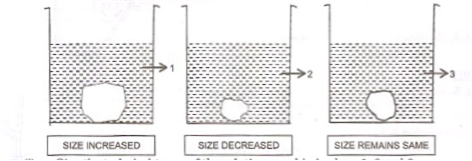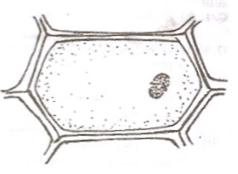Sponsor Area
Absorption By Roots - The Process Involved
A candidate in order to study the process of osmosis has taken 3 potato cubes and put them in 3 different beakers containing 3 different solutions. After 24 hours, in the first beaker the potato cube increased in size, in the second beaker the potato cube decresed in size and in the third beaker there was no change in the size of the potato cube. The following diagram shows the result of the same experiment:
i. Give the technical terms of the solution used in beaker 1 2 and 3
ii. In beaker 3 the size of the potato cube remains the same. Explain the reason in brief
iii. Write the specific feature of the cell sap of root hair a which helps in absorption of water.
iv. What is osmosis?
v. How does a cell wall and a cell membrane differ in their permeability?
i. The technical terms of the solution used in beaker 1 2 and 3
1. Hypotonic
2. Hypertonic
3. Isotonic
ii. The third beaker contains isotonic solution, that is the concentration of the solution is the same as that of the potato cube, Thus, there is no osmosis taking place as there is no concentration gradient. Thus, the cube remains the same as no water is taken or released.
iii. Cell sap is present at a higher concentration that that of the surrounding soil and thus it absorbs water through the process of osmosis.
iv. Osmosis – Is the process of the movement of the solvent molecule from the region of its higher concentration to the region of its lower concentration through a semi-permeable membrane.
v. Cell wall is freely permeable while cell membrane is semi-permeable.
Some More Questions From Absorption By Roots - The Process Involved Chapter
A candidate in order to study the process of osmosis has taken 3 potato cubes and put them in 3 different beakers containing 3 different solutions. After 24 hours, in the first beaker the potato cube increased in size, in the second beaker the potato cube decresed in size and in the third beaker there was no change in the size of the potato cube. The following diagram shows the result of the same experiment:
i. Give the technical terms of the solution used in beaker 1, 2 and 3.
ii. In beaker 3 the size of the potato cube remains the same. Explain the reason in brief
iii. Write the specific feature of the cell sap of root hair a which helps in absorption of water.
iv. What is osmosis?
v. How does a cell wall and a cell membrane differ in their permeability?
i. Give the technical terms of the solution used in beaker 1, 2 and 3.
ii. In beaker 3 the size of the potato cube remains the same. Explain the reason in brief
iii. Write the specific feature of the cell sap of root hair a which helps in absorption of water.
iv. What is osmosis?
v. How does a cell wall and a cell membrane differ in their permeability?
a. The figure given below shows the epidermal cells of an onion bulb. This cell was then transferred to a drop of a sugar solution.

i. Draw a well labelled diagram of the epidermal cell as it would appear after immersion in a strong sugar solution.
ii. what is the scientific term is used for the changes as shown in (i) above?
iii. What should be done to restore the cell back to its original condition?
iv. Give the scientific term for the recovery of the cell as a result of the step taken in (iii) above
v. Define the term osmosis.

i. Draw a well labelled diagram of the epidermal cell as it would appear after immersion in a strong sugar solution.
ii. what is the scientific term is used for the changes as shown in (i) above?
iii. What should be done to restore the cell back to its original condition?
iv. Give the scientific term for the recovery of the cell as a result of the step taken in (iii) above
Give the biological/technical terms for the following:
A solution in which the relative concentration of water molecules and the solute on either side of the cell membrane is the same.
A solution in which the relative concentration of water molecules and the solute on either side of the cell membrane is the same.
Given below are five groups of terms. In each group, arrange and rewrite the terms in the correct order so as to be in a logical sequence.
For example,
Question: Implantation, Parturition, Ovulation, Gestation, Fertilisation.
Answer: Ovulation, Fertilisation. Implantation. Gestation, Parturition.
Endodermis, Cortex. Soli water, Xylem, Root hair
For example,
Question: Implantation, Parturition, Ovulation, Gestation, Fertilisation.
Answer: Ovulation, Fertilisation. Implantation. Gestation, Parturition.
Endodermis, Cortex. Soli water, Xylem, Root hair
Briefly explain the following terms:
Guttation
Guttation
Give biological reasons for the following:
Wooden frames of doors get jammed during the monsoon season.
Wooden frames of doors get jammed during the monsoon season.
Name the following:
i. The process of uptake of mineral ions against the concentration gradient using energy from cell.
i. The process of uptake of mineral ions against the concentration gradient using energy from cell.
Rewrite and complete the following sentences by inserting the correct word
in the space indicated:
The phenomenon of loss of water through a cut stem or injured part of plant is
called __________.
in the space indicated:
The phenomenon of loss of water through a cut stem or injured part of plant is
called __________.
Differentiate between the following pairs on the basis of what is mentioned
within brackets:
i. Diffusion and Osmosis (Definition)
within brackets:
i. Diffusion and Osmosis (Definition)
Explain the following terms:
Turgor pressure
Turgor pressure
Sponsor Area
Mock Test Series
Mock Test Series





